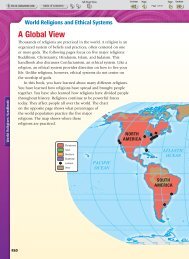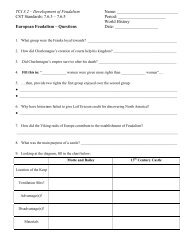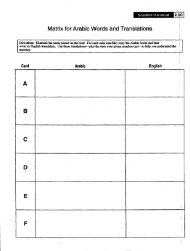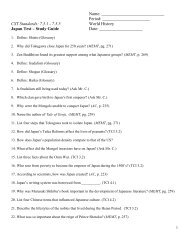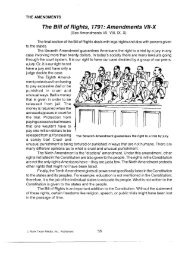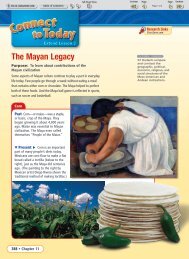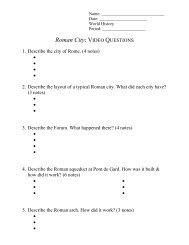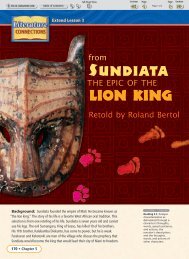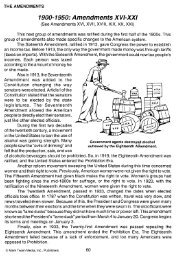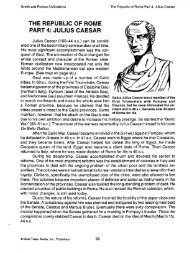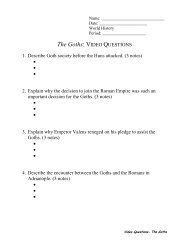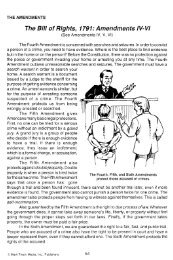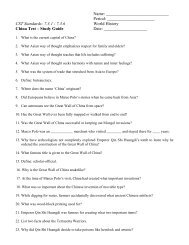What happens when different societies meet? - Teacher
What happens when different societies meet? - Teacher
What happens when different societies meet? - Teacher
Create successful ePaper yourself
Turn your PDF publications into a flip-book with our unique Google optimized e-Paper software.
Interact with History<br />
You are a Native American living on the<br />
northeastern coast of North America. One<br />
day you see a giant boat topped by strange<br />
white cloths. Men climb into smaller boats<br />
and row toward you. You have never seen<br />
men like this. They have pale skin and wear<br />
heavy, colorful clothing. You wonder what<br />
will happen <strong>when</strong> they land.<br />
This European ship spent<br />
weeks at sea to reach the<br />
coast of North America.<br />
<strong>What</strong> <strong>happens</strong><br />
<strong>when</strong> <strong>different</strong><br />
<strong>societies</strong> <strong>meet</strong><br />
<strong>What</strong> Do You Think<br />
• <strong>What</strong> can <strong>different</strong> <strong>societies</strong> learn from<br />
each other<br />
• <strong>What</strong> might they gain from each other<br />
• <strong>What</strong> positive and negative things might<br />
happen <strong>when</strong> they <strong>meet</strong><br />
RESEARCH LINKS<br />
CLASSZONE.COM<br />
Visit the Chapter 1 links for more information<br />
about the first Americans or European voyagers.<br />
800s<br />
Maize is widely grown<br />
in what is now the<br />
southeastern United States.<br />
1000<br />
Viking Leif Erikson<br />
reaches what is now<br />
Newfoundland.<br />
1100s<br />
The city of<br />
Cahokia<br />
flourishes in<br />
what is now<br />
Illinois.<br />
1200s<br />
The Aztecs<br />
conquer much<br />
of central<br />
Mexico.<br />
1492<br />
The European<br />
explorer Columbus<br />
lands in the Americas.<br />
A.D.<br />
1500<br />
Early 600s<br />
Muhammad begins<br />
the religion of Islam<br />
in Arabia.<br />
1096<br />
Europeans begin the<br />
Crusades to capture<br />
the Holy Land from<br />
followers of Islam.<br />
1324<br />
Mansa Musa, emperor of<br />
Mali, travels to Islam’s holy<br />
city. Word of his gold<br />
spreads to Europe.<br />
The World in 1500 25
CHAPTER<br />
1<br />
Reading Strategy: Categorizing Information<br />
<strong>What</strong> Do You Know<br />
<strong>What</strong> do you know about the history of the Americas,<br />
West Africa, and Europe How advanced must a society<br />
be to build large structures<br />
Think About<br />
• what you know about other <strong>societies</strong>, such as Egypt, that built<br />
large structures<br />
• what you’ve read in books<br />
• your responses to the Interact with History about <strong>when</strong><br />
<strong>different</strong> <strong>societies</strong> <strong>meet</strong> (see page 25)<br />
CALIFORNIA STANDARDS<br />
Reading 2.0 Students read<br />
and understand gradelevel-appropriate<br />
material.<br />
They describe and connect<br />
the essential ideas, arguments,<br />
and perspectives<br />
of the text by using their<br />
knowledge of text structure,<br />
organization, and<br />
purpose.<br />
<strong>What</strong> Do You Want to Know<br />
<strong>What</strong> questions do you have about the past <strong>societies</strong> of the Americas,<br />
West Africa, and Europe <strong>What</strong> do you want to know about how they<br />
met Record those questions in your notebook before you read the chapter.<br />
Categorizing Information<br />
One way to make better sense of what you read is to categorize. To categorize is to sort<br />
information into groups. The chart below will help you record information about the<br />
<strong>societies</strong> of the Americas, West Africa, and Europe. As you read, look for information<br />
relating to the categories of trade, technology, religion, and art. Record that information<br />
on your chart.<br />
See Skillbuilder Handbook, page R6.<br />
Taking Notes<br />
Trade<br />
Technology<br />
Religion<br />
Art<br />
AMERICAS<br />
• Trade spread culture.<br />
• Groups exchanged<br />
regional products.<br />
• irrigation<br />
• mound building<br />
• seashell and bone<br />
tools<br />
• sacred places<br />
• sacred animals and<br />
natural forces<br />
• rock paintings<br />
• wooden carvings<br />
• jewelry<br />
• baskets<br />
WEST AFRICA<br />
• Gold was traded<br />
for salt.<br />
• Kingdoms grew rich<br />
on trade.<br />
• Songhai swords<br />
and spears<br />
• Yoruba cast metal<br />
sculpture<br />
• traditional African<br />
religions<br />
• Islam<br />
• wood, ivory, and<br />
metal sculptures<br />
EUROPE<br />
• Trade declined<br />
during Middle Ages.<br />
• Crusades spurred<br />
trade.<br />
• Italy controlled trade<br />
with East.<br />
• printing press<br />
• caravels<br />
• Christianity<br />
• split between<br />
Catholics and<br />
Protestants<br />
• paintings<br />
• statues<br />
26 CHAPTER 1



